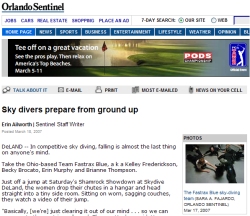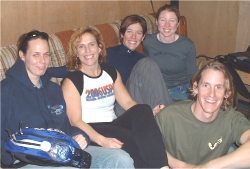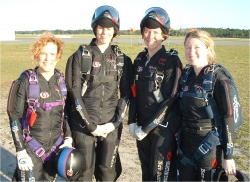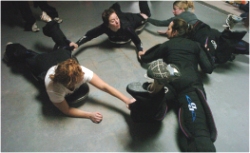
National
Skydiving
League
226 Pecan Street
Deland FL 32724
tel: (386) 801-0804
© 2003 - 2025
All Rights Reserved


226 Pecan Street
Deland FL 32724
tel: (386) 801-0804
© 2003 - 2025
All Rights Reserved

They both watched the activities to write an article for the newspaper. Finally, they decided to pick one of the two all-female line-ups at the FSL Shamrock Showdown 2006 for the story-line, Fastrax Blue.

DeLAND -- In competitive sky diving, falling is almost the last thing on anyone's mind.
Take the Ohio-based Team Fastrax Blue, a k a Kelley Frederickson, Becky Brocato, Erin Murphy and Brianne Thompson.
Just off a jump at Saturday's Shamrock Showdown at Skydive DeLand, the women drop their chutes in a hangar and head straight into a tiny side room. Sitting on worn, sagging couches, they watch a video of their jump.
"Basically, [we're] just clearing it out of our mind . . . so we can move on to the next jump," coach Thomas Hughes said. He sees the ritual as a method of purging for the relatively new team. The Showdown -- commonly known as the East Coast sky-diving season opener -- is the team's first competition together.
After seeing the video, the team is off to memorize and practice the next jump -- a string of random four-person dive formations designated by letters, blocks of moves and numbers put together when someone picks them out of a hat right before the competition.
"Gymnasts all know how to do front flips and back flips . . . [but] imagine if a judge picked out in what order they have to do them," Thompson said, explaining how difficult it is to quickly commit jumps to memory. "For sure in sky diving . . . it's truly, truly mental. The whole thing is memorization."

After jumping out of a plane at 10,500 feet, each team has 35 seconds to perform their moves. The time clock stops at about 4,000 feet and sky divers generally pop their chutes at 3,000 feet.
Fastrax Blue memorizes the jump by visualizing the moves, then rolling around on "creepers" -- torso-shaped boards on wheels that allow sky divers to simulate the belly-to-Earth position of free fall.Meanwhile, a team of professional "packers" fluff and fold, knead and roll jellyfish-like billows of the team's jewel-toned nylon parachutes into compact backpacks.
A taxing job for many, it takes a "nylon artist" about five minutes to slick a chute into a small enough bundle that it will fit back into its bag. If it is done incorrectly, a chute could open too fast or twist and cause a jumper trouble in the air.

Without professional packers, the Fastrax Blue women joked, they aren't sure they would stay in the sport.
"That's hard work," Brocato said. "If we're trying to do that and jump . . ."
Frederickson chimed in: "I wouldn't keep sky diving."
A lot of jumpers feel that way, said Kurt Gaebel, with the National Skydiving League.
"Especially in a competition, you don't want to deal with things like packing a parachute . . . that get in the way of your job, which is scoring as many points as possible during a free fall," Gaebel said.

While going through the Round 4 jump -- 3-21-16, or Side Flake Opal-Turf, Zig Zag-Marquis, Compressed Accordion-Box -- the women do several rounds in a mock-up, which simulates the airplane from which they will jump. After exiting the mock-up, they twirl and twist, link arms and break apart in a standing version of what they did earlier on the creepers.
"We have an exit count," Thompson explained of how they know when to leave the plane. "It's like a shake-shake-shake and then it's ready-set-go. We don't really vocalize it. It's all through our expressions and grip."

He dives with the team, filming their moves for the judges. If he misses something, the team suffers.
"I'm kind of like a goalie: I don't make any points, but I sure can cost them the game," Redinbo said.
On the ground again, the process starts all over: Video, creeper, mock-up, jump.
In the viewing area, sky diver Lance Smith watches his fellow athletes float from the sky like dandelion seeds on the wind.
"You don't feel like you're dropping, so you don't get that sinking feeling," he said. "You hit the wind. It's a wind rush right by you . . . 600 jumps later and it's still a rush."